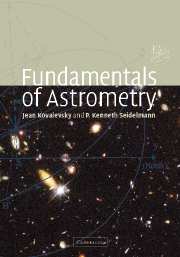Book contents
- Frontmatter
- Contents
- Preface
- List of abbreviations
- 1 Introduction
- 2 New observational techniques
- 3 Basic principles and coordinate systems
- 4 Treatment of astronomical data
- 5 Principles of relativity
- 6 Apparent displacements of celestial objects
- 7 Extragalactic reference frame
- 8 Dynamical reference frame
- 9 Terrestrial coordinate systems
- 10 Earth orientation
- 11 Stars
- 12 Double and multiple star systems
- 13 Astronomical phenomena
- 14 Applications to observations
- Appendix A Examples
- Appendix B Astronomical values
- Glossary
- References
- Index
5 - Principles of relativity
Published online by Cambridge University Press: 05 November 2011
- Frontmatter
- Contents
- Preface
- List of abbreviations
- 1 Introduction
- 2 New observational techniques
- 3 Basic principles and coordinate systems
- 4 Treatment of astronomical data
- 5 Principles of relativity
- 6 Apparent displacements of celestial objects
- 7 Extragalactic reference frame
- 8 Dynamical reference frame
- 9 Terrestrial coordinate systems
- 10 Earth orientation
- 11 Stars
- 12 Double and multiple star systems
- 13 Astronomical phenomena
- 14 Applications to observations
- Appendix A Examples
- Appendix B Astronomical values
- Glossary
- References
- Index
Summary
For many years, the theory of relativity was ignored for astrometry because the effects were much smaller than the accuracies being achieved. For the motions of bodies of the Solar System, Newtonian theory was adequate, provided that some relativistic corrections were introduced. Actually, there was a long period of questioning whether the theory of relativity was correct or not, and thus relativistic corrections were introduced in a manner to determine whether observational data could then be better represented.
However, over the past 30 years, there has been a very significant improvement in the accuracies of observations, all confirming the conclusions of general relativity. So its introduction became not only acceptable, but necessary. In 1976, the International Astronomical Union introduced relativistic concepts of time and the transformations between various time scales and reference systems. In 1991, it extended them to reference frames and to astrometric quantities. Now, with plans for microarcsecond astrometry and with time standards approaching accuraries of one part in 10-16, and better in the future, it is necessary to base all astrometry, reference systems, ephemerides, and observational reduction procedures on consistent relativistic grounds. This means that relativity must be accepted in its entirety, and that concepts, as well as practical problems, must be approached from a relativistic point of view. In 2000, the IAU enforced this approach further by extending the 1991 models for future requirements in such a way that they become valid to accuracies several orders better than those currently achieved in 2000.
- Type
- Chapter
- Information
- Fundamentals of Astrometry , pp. 93 - 120Publisher: Cambridge University PressPrint publication year: 2004



